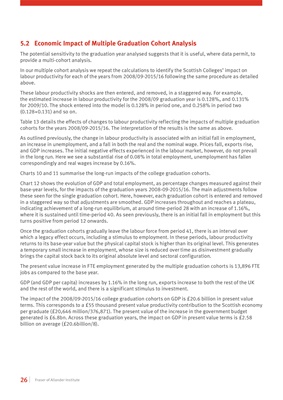
26 Fraser of Allander Institute
5.2 Economic Impact of Multiple Graduation Cohort Analysis
The potential sensitivity to the graduation year analysed suggests that it is useful, where data permit, to
provide a multi-cohort analysis.
In our multiple cohort analysis we repeat the calculations to identify the Scottish Colleges' impact on
labour productivity for each of the years from 2008/09-2015/16 following the same procedure as detailed
above.
These labour productivity shocks are then entered, and removed, in a staggered way. For example,
the estimated increase in labour productivity for the 2008/09 graduation year is 0.128%, and 0.131%
for 2009/10. The shock entered into the model is 0.128% in period one, and 0.258% in period two
(0.128+0.131) and so on.
Table 13 details the effects of changes to labour productivity reflecting the impacts of multiple graduation
cohorts for the years 2008/09-2015/16. The interpretation of the results is the same as above.
As outlined previously, the change in labour productivity is associated with an initial fall in employment,
an increase in unemployment, and a fall in both the real and the nominal wage. Prices fall, exports rise,
and GDP increases. The initial negative effects experienced in the labour market, however, do not prevail
in the long run. Here we see a substantial rise of 0.08% in total employment, unemployment has fallen
correspondingly and real wages increase by 0.16%.
Charts 10 and 11 summarise the long-run impacts of the college graduation cohorts.
Chart 12 shows the evolution of GDP and total employment, as percentage changes measured against their
base-year levels, for the impacts of the graduation years 2008-09-2015/16. The main adjustments follow
these seen for the single graduation cohort. Here, however, each graduation cohort is entered and removed
in a staggered way so that adjustments are smoothed. GDP increases throughout and reaches a plateau,
indicating achievement of a long-run equilibrium, at around time-period 28 with an increase of 1.16%,
where it is sustained until time-period 40. As seen previously, there is an initial fall in employment but this
turns positive from period 12 onwards.
Once the graduation cohorts gradually leave the labour force from period 41, there is an interval over
which a legacy effect occurs, including a stimulus to employment. In these periods, labour productivity
returns to its base-year value but the physical capital stock is higher than its original level. This generates
a temporary small increase in employment, whose size is reduced over time as disinvestment gradually
brings the capital stock back to its original absolute level and sectoral configuration.
The present value increase in FTE employment generated by the multiple graduation cohorts is 13,896 FTE
jobs as compared to the base year.
GDP (and GDP per capita) increases by 1.16% in the long run, exports increase to both the rest of the UK
and the rest of the world, and there is a significant stimulus to investment.
The impact of the 2008/09-2015/16 college graduation cohorts on GDP is £20.6 billion in present value
terms. This corresponds to a £55 thousand present value productivity contribution to the Scottish economy
per graduate (£20,646 million/376,871). The present value of the increase in the government budget
generated is £6.8bn. Across these graduation years, the impact on GDP in present value terms is £2.58
billion on average (£20.6billion/8).